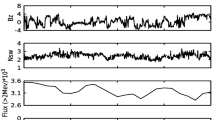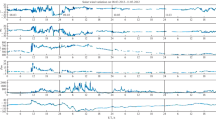Abstract
Geomagnetic storms occur due to solar wind-magnetosphere couplings which are amplified by solar wind disturbances (coronal mass ejection phenomena) that are accompanied by southward turning of interplanetary magnetic field (Bz). The geomagnetic disturbance of 17 March 2015 is caused by a coronal mass ejection (CME) of solar cycle 24 with lowest disturbance storm time (Dst) value of –223 nT is explored. The impact of CME was extensively examined using the geoelectric field (EH), time derivatives of the north (dX/dt), east (dY/dt) and vertical (dZ/dt) components of the geomagnetic field across ten geomagnetic observatories. The amplitudes of dX/dt, dY/dt and dZ/dt in the auroral zone are higher than those in the sub-auroral zone during the disturbed conditions. Wavelet power spectrum (WPS) techniques are used to examine the variation of EH and dZ/dt at both auroral zone and sub-auroral zone. The result shows that high latitude of the geomagnetic stations (BJN and MAS) demonstrate larger amplitude of the wavelet coefficients, while for lower geomagnetic stations (OUJ and PEL) display low wavelet coefficients of geomagnetic storms observed on 17 March 2015. It was noticed that the huge dZ/dt is noticed during nighttime due to a global scale equatorial zonal electric field during the geomagnetic disturbance. This validates the concepts of penetration of charged particles and significant transfer of energy to the magnetosphere at high latitudes, which are considered by the phenomena that lead to high coefficients of wavelet power spectrum.









Similar content being viewed by others
REFERENCES
Adam, A., Prácser, E., and Wesztergom, V., Estimation of the electric resistivity distribution (EURHOM) in the European lithosphere in the frame of the EURISGIC WP2 project, Acta Geod. Geophys. Hung., 2012, vol. 47, pp. 377–387. https://doi.org/10.1556/AGeod.47.2012.4.1
Boteler, D., Pirjola, R., and Nevanlinna, H.T., The effects of geomagnetic disturbances on electrical systems at the Earth’s surface, Adv. Space Res., 1998, vol. 22, pp. 17–27.
Castillo, E., Morales, D.P., Botella, G., Garcia, A., Parrilla, L., and Palma, A.J., Efficient wavelet-based ECG processing for single-lead FHR extraction, Digital Signal Process., 2013, vol. 23, no. 6, pp. 1897–1909.
Echer, E. and Gonzalez, W.D., Geoeffectiveness of interplanetary shocks magnetic clouds, sector boundary crossings and their combined occurrence, J. Geophys. Res. Lett., 2004, vol. 31, no. 9. https://doi.org/10.1029/2003GL019199
Falayi, E.O., Adebesin, B.O., and Bolaji, O.S., The impact of coronal mass ejection on the horizontal geomagnetic fields and the induced geoelectric fields, Adv. Space Res., 2018a, vol. 61, no. 3, pp. 985–1003.
Falayi, E.O., Adepitan, J.O., and Oyebanjo, O.A., Geomagnetic field H, Z, and electromagnetic induction features of coronal mass ejections in association with geomagnetic storm at African longitudes, Can. J. Phys., 2018b, vol. 96, no. 6, pp. 654–663. https://doi.org/10.1139/cjp-2017-0460
Falayi, E.O., Adewole, A.T., Adelaja, A.D., Ogundile, O.O., and Roy-Layinde, T.O., Study of nonlinear time series and wavelet power spectrum analysis using solar wind parameters and geomagnetic indices, NRIAG J. Astron. Geophys., 2020, vol. 9, no. 1, pp. 226–237. https://doi.org/10.1080/20909977.2020.1728866
Grossman, A. and Morlet, J., Decomposition of Hardy functions into square integrable wavelets of constant shape, SIAM J. Math. Anal., 1984, vol. 15, pp. 723–736.
Han, X.H. and Chang, X.M., An intelligent noise reduction method for chaotic signals based on genetic algorithms and lifting wavelet transforms, Inf. Sci., 2013, vol. 218, pp. 103–118.
International Monitor for Auroral Geomagnetic Effects (IMAGE), 2015. http://space.fmi.fi/image/www/index.php.
Kamide, Y. and Kusano, K., No major solar flares but the largest geomagnetic storm in the present solar cycle, Space Weather, 2015, vol. 13, pp. 365–367. https://doi.org/10.1002/2015SW001213.
Kamide, Y., Yokoyama, N., Gonzalez, W., Tsurutani, B.T., Daglis, I.A., Brekke, A., and Masuda, S., Two-step development of geomagnetic storms, J. Geophys. Res., 1998, vol. 103, pp. 6917– 6922. https://doi.org/10.1029/97JA03337
Kataoka, R., Shiota, D., Kilpua, E., and Keika, K., Pileup accident hypothesis of magnetic storm on 17 March 2015, J. Geophys. Res. Lett., 2015, vol. 42, no. 13, pp. 5155–5161. https://doi.org/10.1002/2015GL064816
Katsuhide, M., Kyung-Suk, C., Rok-Soon, K., Sujin, K., Sung-Hong, P., and Hiromitsu, I., The 17 March 2015 storm: The associated magnetic flux rope structure and the storm development, Earth, Planets Space, 2016, vol. 68, id 173.
Liu, Y.D., Luhmann, J.G., Kajdič, P., Kilpua, E.K.J., Lugaz, N., Nitta, N.V., Möstl, C., Lavraud, B., Bale, S.D., Farrugia, C.J., and Galvin, A.B., Observations of an extreme storm in interplanetary space caused by successive coronal mass ejections, Nat. Commun., 2014, vol. 5, id 3481. https://doi.org/10.1038/ncomms4481
Liu, Y.D., Hu, H., Wang, R., Yang, Z., Zhu, B., Liu, Y., Luhmann, J.G., and Richardson, J.D., Plasma and magnetic field characteristics of solar coronal mass ejections in relation to geomagnetic storm intensity and variability, Astron. J. Lett., 2015, vol. 809, no. 2, pp. 1–15.
McAllister, A.H. and Crooker, N.U., Coronal mass ejections, corotating interaction regions, and geomagnetic storms, in Coronal Mass Ejections, Crooker, N., Joselyn, J.A., and Feynman, J., Eds., Washington, DC: Am. Geophys. Union, 1997, vol. 99, pp. 279–289. https://doi.org/10.1029/GM099p0279.
Myllys, M., Viljanen, A., Rui, O., and Magne Ohnstad, T., Geomagnetically induced current in Norway: The northern most high voltage power grid in the world, J. Space Weather Space Clim., 2014, vol. 4, pp. 1–8. https://doi.org/10.1051/swsc/2014007
NASA, Interface to produce plots, listings or output files from OMNI, 2015. http://omniweb.gsfc.nasa.gov/html/omni_min_data.html.
Piersanti, M., Alberti, T., Bemporad, A., Berrilli, F., Bruno, R., Capparelli, V., Carbone, V., Consolini, G., Cristaldi, A., Del Corpo, A., Del Moro, D., Di Matteo, S., Ermolli, I., Fineschi, S., Giannattasio, F., et al., Comprehensive Sun-to-Earth analysis of the geoeffective solar event of June 21, 2015: Effects on the magnetosphere–plasmasphere–ionosphere system, Sol. Phys., 2017, vol. 292, id 169.
Ram, S.T., Yokoyama, T., Otsuka, Y., Shiokawa, K., Sripathi, S., Veenadhari, B., Heelis, R., Ajith, K.K., Gowtam, V.S., Gurubaran, S., Supnithi, P., and Le Huy, M., Duskside enhancement of equatorial zonal electric field response to convection electric fields during the St. Patrick’s Day storm on 17 March 2015, J. Geophys. Res.: Space Phys., 2015, vol. 121, pp. 538–548.
Ramsingh, Sripathi, S., Sreeba, S., Banola, S., Emperumal, K., Tiwari, P., and Burudu, S.K., Low-latitude ionosphere response to Super geomagnetic storm of 17/18 march 2015: Results from a chain of ground-based observations over Indian sector, J. Geophys. Res.: Space Phys., 2015, vol. 120, pp. 10 864–10 882. https://doi.org/10.1002/2015JA021509
Rangarajan, G.K., Indices of Geomagnetic Activity in Geomagnetism, London: Academic, 1989.
Sugiura, M., Hourly Values of Equatorial Dst for the IGY, Oxford, UK: Pergamon, 1964.
Tsurutani, B.T., Gonzalez, W.D., Tang, F., Akasofu, S.I., and Smith, E.J., Origin of interplanetary southward magnetic fields responsible for major magnetic storms near solar maximum (1978–1979), J. Geophys. Res., 1988, vol. 93, pp. 8519–8531.
Tsurutani, B.T. and Gonzalez, W.D., The interplanetary causes of magnetic storms: A review, in Magnetic Storms, Tsurutani, B.T., Gonzalez, W.D., Kamide, Y., and Arballo, J.K., Eds., Washington, DC: Am. Geophys. Union, 1997, vol. 98, pp. 77–89. https://doi.org/10.1029/GM098p0077.
Viljanen, A., Nevanlinna, H., Pajunpaa, K., and Pulkki-nen, A., Time derivatives of the horizontal geomagnetic field as an activity indicator, Ann. Geophys., 2001, vol. 19, pp. 1107–1118.
Viljanen, A., Pirjola, R., Prácser, E., Katkalov, J., and Wik, M., Continental scale modeling of geomagnetically induced currents, J. Space Weather Space Clim., 2014, vol. 4, id A09. https://doi.org/10.1051/swsc/2014006
Wang, Y.M., Zhou, Z., Shen, C., Lui, R., and Wang, S., Investigating plasma motion of magnetic clouds at 1 AU through a velocity-modified cylindrical force free flux tope model, J. Geophys. Res., 2015, vol. 120, pp. 1543–1565.
Weigel, R.S., Klimas, A., and Vassiliadis, D., Solar wind coupling to and predictability of ground magnetic field and their time derivatives, J. Geophys. Res., 2003, vol. 108, no. A7.
Wintoft, P., Study of the solar wind coupling to the time difference horizontal geomagnetic field, Ann. Geophys., 2005, vol. 23, pp. 1949–1957.
Wu, C.-C. and Lepping, R.P., Geomagnetic activity associated with magnetic clouds, magnetic cloud-like structures and interplanetary shocks for the period 1995–2003, Adv. Space Res., 2008, vol. 41, pp. 335–338.
Wu, C.-C. and Lepping, R.P., Relationships among geomagnetic storms, interplanetary shocks, magnetic clouds, and sunspot number during 1995–2012, Sol. Phys., 2016, vol. 291, pp. 265–284.
ACKNOWLENGMENTS
The authors acknowledge the International Monitor for Auroral Geomagnetic Effects (IMAGE) (http://space.fmi.fi/ image/www/index.php), for the provision of the geomagnetic field and the Flight Center Space Physics Data Facility (GSFC/SPDF), OMNIWEB interface (https://omniweb. gsfc.nasa.gov/form/omni_min.html), for the provision of SW, Psw, Bz, SYM-H, AU, and AL. The conductivity structure of Europe 1D/2D models and conductance obtained from http;//real.mtak.hu/2957.
Author information
Authors and Affiliations
Corresponding authors
Rights and permissions
About this article
Cite this article
Falayi, E.O., Adepitan, J.O. & Ogundile, O.O. Analysis of Geomagnetic and Geoelectric Fields During Geomagnetic Storm Time Variation Using Wavelet Approach. Geomagn. Aeron. 62, 482–494 (2022). https://doi.org/10.1134/S0016793222040077
Received:
Revised:
Accepted:
Published:
Issue Date:
DOI: https://doi.org/10.1134/S0016793222040077




